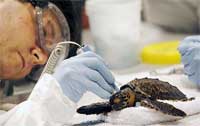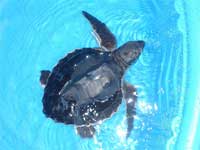Sea turtles and sea turtle nests have been affected by the oil disaster.
Since the explosion on the Deepwater Horizon oil rig in the Gulf of Mexico on April 20, 2010, concern over the impact the oil disaster will have on wildlife in the region has grown. Of the five species of sea turtle considered native to the region, three are listed as Critically Endangered on the International Union for Conservation of Nature Red List, while two are listed as Endangered. Several organizations across the country are taking steps to reduce the impact on these species — both by rescuing oiled turtles and relocating sea turtle nests to oil-free areas.
The Louisiana Marine Mammal and Sea Turtle Rescue Program, along with a large network of supporters, is rescuing and rehabilitating injured sea turtles in the Gulf, with the goal of rereleasing them into the wild. This program is coordinated by the Audubon Aquarium of the Americas in New Orleans, La.
Sea Turtle Care
Once the Audubon rescue team receives a call for a distressed sea turtle, it picks up the animal and transports it to the Audubon Aquatic Center. At the center, each sea turtle moves through three zones — red, yellow and green.
In the red zone, turtles are examined and treated by a veterinarian and given their first oil-removal bath. To speed up the cleaning process, a thin layer of vegetable oil is applied to the turtles. Dawn dishwashing soap and a toothbrush are then used to clean the skin and carapace. Mayonnaise is used to clean out the mouth and eyes, as it works to break down the oil and makes cleaning these parts easier.
The animal is then held in the yellow zone for observation and treatment, and it receives a second bath. The sea turtles could be given a single, longer bath rather than two, but breaking the cleaning up into two parts reduces the amount of stress on the animals.
Once the vet gives a sea turtle the “all clear,” it’s taken to the green zone. This happens when the sea turtle is no longer highly contaminated by oil but still in need of treatment. In the green zone, it receives medical attention and is closely observed.
The Audubon Aquatic Center is currently housing 121 turtles, as well as an injured bottlenose dolphin. Most of the sea turtles are Kemp’s Ridley sea turtles (Lepidochelys kempii), listed as Critically Endangered by the IUCN Red List. Four of the turtles, also Kemp’s Ridley sea turtles, are not considered oil-affected at this point, but were brought in for evaluation.
As of this writing, three of the rescued sea turtles have died, and Audubon biologists said that the turtle mortality rate for oiled turtles could be as high as 50 percent. There is little documentation on the effects that oil has on sea turtles.
The rescue and rehabilitation of each sea turtle is estimated to cost $5,000, including equipment, supplies, medication and veterinary staff. Public Relations Manager at the Audubon Nature Institute Megan Calhoun said, “Audubon Nature Institute is prepared to care and house these turtles for as long as necessary, until it is deemed safe for their return to the Gulf of Mexico.”
Calhoun said that the sea turtles may eventually be released off the eastern coast of Florida, into waters not affected by the oil disaster, but the decision will be made by the National Oceanic and Atmospheric Administration (NOAA).
It is too early to tell what effects the oil disaster will have on sea turtle populations. The Audubon Nature Institute will evaluate not just the impact of the oil disaster on sea turtles and their environment, but also the impact the use of oil dispersants will have on them.
“Every turtle that we are able to rehabilitate back to health and return to their natural environment is one more turtle to help with future generations,” Calhoun said.
Sea Turtle Nest Relocation
On July 9, the first of several sea turtle nests was dug up and relocated to the east coast of Florida. In the coming weeks, several hundred nests, on beaches from Alabama to west Florida, will be relocated by state and federal wildlife agencies.
Biologists agree that moving sea turtle nests is risky, but the conservation and wildlife agencies involved decided that the sea turtle hatchlings will have a better chance of survival if they are released into waters not affected by the Deepwater Horizon oil disaster. The relocation is being organized by the United States Fish and Wildlife Service, the Florida Fish and Wildlife Conservation Commission, the National Park Service, NOAA and other conservationists.
After being excavated, the eggs are packed into temperature-controlled foam containers and transported to a climate-controlled facility adjacent to the Kennedy Space Center.
Out of the first nest, 83 percent of the sea turtles hatched. They were then released into the waters off of Cape Canaveral, Fla.
Some of the dangers involved in the project include transporting the fragile eggs from the northern Gulf Coast to eastern Florida, hatching them under warehouse conditions, and releasing them into the Atlantic Ocean instead of Gulf Coast waters.
Sea turtles nest from May to August, and their hatching season lasts from July to October. About 700 nests will be moved, most created by loggerhead sea turtles (Caretta caretta).






